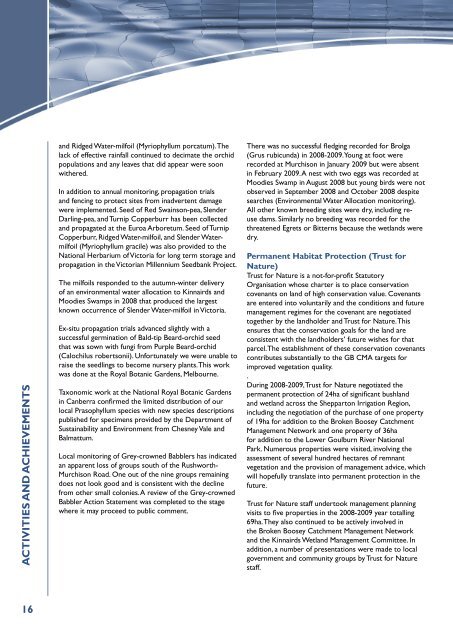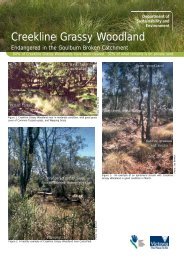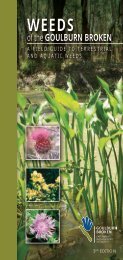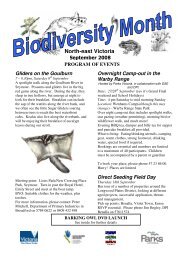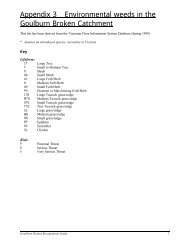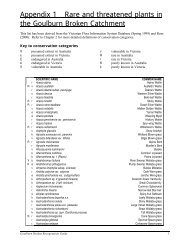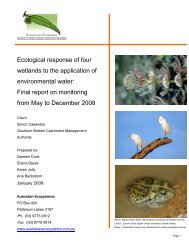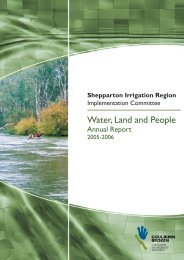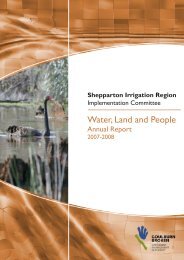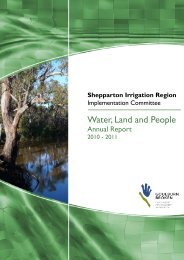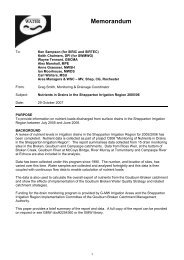Water, Land and People - Goulburn Broken Catchment ...
Water, Land and People - Goulburn Broken Catchment ...
Water, Land and People - Goulburn Broken Catchment ...
You also want an ePaper? Increase the reach of your titles
YUMPU automatically turns print PDFs into web optimized ePapers that Google loves.
ACTIVITIES AND ACHIEVEMENTS<br />
16<br />
<strong>and</strong> Ridged <strong>Water</strong>-milfoil (Myriophyllum porcatum). The<br />
lack of effective rainfall continued to decimate the orchid<br />
populations <strong>and</strong> any leaves that did appear were soon<br />
withered.<br />
In addition to annual monitoring, propagation trials<br />
<strong>and</strong> fencing to protect sites from inadvertent damage<br />
were implemented. Seed of Red Swainson-pea, Slender<br />
Darling-pea, <strong>and</strong> Turnip Copperburr has been collected<br />
<strong>and</strong> propagated at the Euroa Arboretum. Seed of Turnip<br />
Copperburr, Ridged <strong>Water</strong>-milfoil, <strong>and</strong> Slender <strong>Water</strong>milfoil<br />
(Myriophyllum gracile) was also provided to the<br />
National Herbarium of Victoria for long term storage <strong>and</strong><br />
propagation in the Victorian Millennium Seedbank Project.<br />
The milfoils responded to the autumn-winter delivery<br />
of an environmental water allocation to Kinnairds <strong>and</strong><br />
Moodies Swamps in 2008 that produced the largest<br />
known occurrence of Slender <strong>Water</strong>-milfoil in Victoria.<br />
Ex-situ propagation trials advanced slightly with a<br />
successful germination of Bald-tip Beard-orchid seed<br />
that was sown with fungi from Purple Beard-orchid<br />
(Calochilus robertsonii). Unfortunately we were unable to<br />
raise the seedlings to become nursery plants. This work<br />
was done at the Royal Botanic Gardens, Melbourne.<br />
Taxonomic work at the National Royal Botanic Gardens<br />
in Canberra confirmed the limited distribution of our<br />
local Prasophyllum species with new species descriptions<br />
published for specimens provided by the Department of<br />
Sustainability <strong>and</strong> Environment from Chesney Vale <strong>and</strong><br />
Balmattum.<br />
Local monitoring of Grey-crowned Babblers has indicated<br />
an apparent loss of groups south of the Rushworth-<br />
Murchison Road. One out of the nine groups remaining<br />
does not look good <strong>and</strong> is consistent with the decline<br />
from other small colonies. A review of the Grey-crowned<br />
Babbler Action Statement was completed to the stage<br />
where it may proceed to public comment.<br />
There was no successful fledging recorded for Brolga<br />
(Grus rubicunda) in 2008-2009. Young at foot were<br />
recorded at Murchison in January 2009 but were absent<br />
in February 2009. A nest with two eggs was recorded at<br />
Moodies Swamp in August 2008 but young birds were not<br />
observed in September 2008 <strong>and</strong> October 2008 despite<br />
searches (Environmental <strong>Water</strong> Allocation monitoring).<br />
All other known breeding sites were dry, including reuse<br />
dams. Similarly no breeding was recorded for the<br />
threatened Egrets or Bitterns because the wetl<strong>and</strong>s were<br />
dry.<br />
Permanent Habitat Protection (Trust for<br />
Nature)<br />
Trust for Nature is a not-for-profit Statutory<br />
Organisation whose charter is to place conservation<br />
covenants on l<strong>and</strong> of high conservation value. Covenants<br />
are entered into voluntarily <strong>and</strong> the conditions <strong>and</strong> future<br />
management regimes for the covenant are negotiated<br />
together by the l<strong>and</strong>holder <strong>and</strong> Trust for Nature. This<br />
ensures that the conservation goals for the l<strong>and</strong> are<br />
consistent with the l<strong>and</strong>holders’ future wishes for that<br />
parcel. The establishment of these conservation covenants<br />
contributes substantially to the GB CMA targets for<br />
improved vegetation quality.<br />
.<br />
During 2008-2009, Trust for Nature negotiated the<br />
permanent protection of 24ha of significant bushl<strong>and</strong><br />
<strong>and</strong> wetl<strong>and</strong> across the Shepparton Irrigation Region,<br />
including the negotiation of the purchase of one property<br />
of 19ha for addition to the <strong>Broken</strong> Boosey <strong>Catchment</strong><br />
Management Network <strong>and</strong> one property of 36ha<br />
for addition to the Lower <strong>Goulburn</strong> River National<br />
Park. Numerous properties were visited, involving the<br />
assessment of several hundred hectares of remnant<br />
vegetation <strong>and</strong> the provision of management advice, which<br />
will hopefully translate into permanent protection in the<br />
future.<br />
Trust for Nature staff undertook management planning<br />
visits to five properties in the 2008-2009 year totalling<br />
69ha. They also continued to be actively involved in<br />
the <strong>Broken</strong> Boosey <strong>Catchment</strong> Management Network<br />
<strong>and</strong> the Kinnairds Wetl<strong>and</strong> Management Committee. In<br />
addition, a number of presentations were made to local<br />
government <strong>and</strong> community groups by Trust for Nature<br />
staff.


